

Truman State University Press. Jean Jennings Bartik; edited by Jon T.
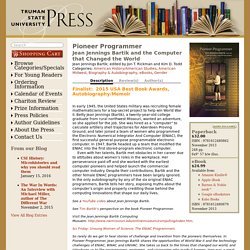
Rickman and Kim D. Todd Finalist: 2015 USA Best Book Awards, Autobiography/Memoir In early 1945, the United States military was recruiting female mathematicians for a top-secret project to help win World War II. Betty Jean Jennings (Bartik), a twenty-year-old college graduate from rural northwest Missouri, wanted an adventure, so she applied for the job. Dr. Grace Murray Hopper: COBOL Computer Language.
Inventor Grace Murray Hopper was a curious child.
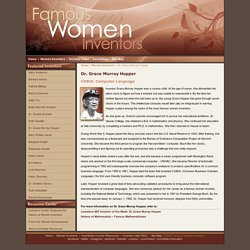
At the age of seven, she dismantled her alarm clock to figure out how it worked, but was unable to reassemble it. By the time her mother figured out what she had been up to, the young Grace Hopper had gone through seven clocks in the house. This intellectual curiousity would later play an integral part in earning Hopper a place among the ranks of the most famous women inventors. As she grew up, Grace's parents encouraged her to pursue her educational ambitions.
At Vassar College, she obtained a B.A. in mathematics and physics. 25147356. WomenOfENIAC. p175 gurer. Women, Feminism and Computers. Hedy Lamarr. During her film career, Lamarr co-invented the technology for spread spectrum and frequency hopping communications with composer George Antheil.[3] This new technology became important to America's military during World War II because it was used in controlling torpedoes.
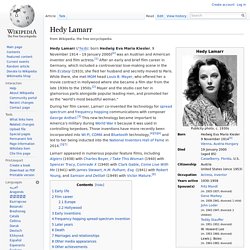
Those inventions have more recently been incorporated into Wi-Fi, CDMA and Bluetooth technology,[4][5][6] and led to her being inducted into the National Inventors Hall of Fame in 2014.[3][7] §Early life[edit] Lamarr was born Hedwig Eva Maria Kiesler in 1914 in Vienna, Austria-Hungary, the only child of Gertrud "Trude" Kiesler (née Lichtwitz; 3 February 1894 – 27 February 1977) and Emil Kiesler (27 December 1880 – 14 February 1935). §Film career[edit] §Europe[edit] Friedrich Mandl, her first husband, objected to what he felt was exploitation of his wife and "the expression on her face" during the simulated orgasm.
Lamarr wrote that Mussolini and Hitler had attended lavish parties hosted at the Mandl home. §Hollywood[edit] Cwomen. Grace Hopper - Military Leader, Mathematician, Computer Programmer. Computer programmer Grace Hopper helped develop a compiler that was a precursor to the widely used COBOL language and became a rear admiral in the U.S.
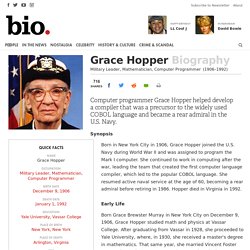
Navy. Synopsis Born in New York City in 1906, Grace Hopper joined the U.S. Navy during World War II and was assigned to program the Mark I computer. She continued to work in computing after the war, leading the team that created the first computer language compiler, which led to the popular COBOL language. Early Life. Hedy Lamarr. Notable Women in Computing Card Deck by Jessica Dickinson Goodman. The Forgotten Female Programmers Who Created Modern Tech : All Tech Considered. Jean Jennings (left) and Frances Bilas set up the ENIAC in 1946.

Bilas is arranging the program settings on the Master Programmer. Courtesy of University of Pennsylvania hide caption toggle caption Courtesy of University of Pennsylvania Jean Jennings (left) and Frances Bilas set up the ENIAC in 1946. Bilas is arranging the program settings on the Master Programmer. Courtesy of University of Pennsylvania If your image of a computer programmer is a young man, there's a good reason: It's true.
It wasn't always this way. I took a trip to ground zero for today's computer revolution, Stanford University, and randomly asked over a dozen students if they knew who were the first computer programmers. The Women Who Made Our Video Games Possible. Women have been major contributors to science, technology, and video games, but we don’t always hear about them!

It’s time to change that. Women have helped build our computers from the ground up, have been major developers in video game fields, have made mobile gaming possible, and have even established international organizations to further women’s involvement in computing, engineering, and technology! During Women’s History Month, it’s imperative that we recognize them. Computers are so prevalent in today’s society; smartphones, cash registers, TVs, and even microwaves have computing elements within them. But, it’s not common knowledge that a woman is credited with writing the first computer program. Since computers were still a little further out in the future, groups of people were enlisted to become “computers.” The 15 Most Important Women in Tech History. Do a quick Google News search for "women in technology" and your results are sure to be bemoaning the lack of female bodies in the industry (or maybe just results for that White Town album).

Last year both the NYT and the WSJ had articles related to the topic – and published within a few weeks of each other – with the WSJ’s title being “Addressing the Lack of Women Leading Tech Start-Ups” and the intro to the NYT piece setting the tone with: “It’s become a familiar lament: Where are the women in technology?” Likewise, the Wikipedia entry for "Women in Computing" focuses almost entirely on the decline of women in tech-related fields, the modern day fights against sexism in the industry, and has sections like "Attracting women in computer science" and "Gender theory and women in computing. " (Interesting side note: there is no entry for "Men in computing. ") Very rarely do stories of women and technology vary in tone from the gender gap theme. Women and Coding have a long History! Women and Coding have a long History!
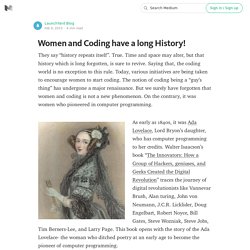
They say “history repeats itself”. True. Time and space may alter, but that history which is long forgotten, is sure to revive. Saying that, the coding world is no exception to this rule. Today, various initiatives are being taken to encourage women to start coding. As early as 1840s, it was Ada Lovelace, Lord Bryon’s daughter, who has computer programming to her credits.
It was a time then, when girls were more into mathematics while guys preferred to tinker with the hardware. Slowly, the curve saw its downfall. A curve always has a parabolic movement. For instance, year 2014 saw the non-profit campaign “Year of Code”, with an aim to convince schools to have coding courses for students, courtesy the 2013 reports by American Association of University Women stating about “unsupportive classroom environments and outdated pedagogy and a limited peer group”.